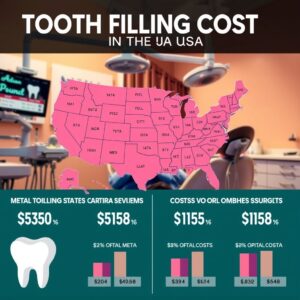Tooth Filling Cost in the USA
Dental fillings are one of the most common dental procedures in the United States, with millions performed each year to treat cavities and restore tooth integrity. However, the cost of a tooth filling can vary significantly depending on multiple factors, including the filling material, location, and whether you have dental insurance.
For many Americans, the expense of dental care can be a major concern. Understanding the costs, insurance coverage, and affordable alternatives can help you make informed decisions about your oral health. This guide provides an in-depth look at tooth filling costs in the USA, including a breakdown by material, state averages, and money-saving tips.

2. What Is a Dental Filling?
A dental filling is a restorative treatment used to repair a tooth damaged by decay, cracks, or wear. The dentist removes the decayed portion, cleans the area, and fills the cavity with a durable material to restore the tooth’s function and shape.
Fillings prevent further decay and protect the tooth from additional damage. If left untreated, cavities can lead to severe pain, infections, and even tooth loss.
3. Types of Dental Fillings and Their Costs
The cost of a filling largely depends on the material used. Below is a detailed comparison:
A. Amalgam (Silver) Fillings
-
Cost: $50 – $150 per tooth
-
Pros: Durable, long-lasting (10-15 years), affordable
-
Cons: Contains mercury (debated safety), not aesthetically pleasing
B. Composite Resin Fillings
-
Cost: $90 – $300 per tooth
-
Pros: Tooth-colored, bonds well with enamel, good for small to medium cavities
-
Cons: Less durable than amalgam (5-10 years), more expensive
C. Ceramic (Porcelain) Fillings
-
Cost: $250 – $4,500 (inlays/onlays)
-
Pros: Natural appearance, stain-resistant, long-lasting
-
Cons: Expensive, requires multiple visits
D. Gold Fillings
-
Cost: $250 – $4,500
-
Pros: Extremely durable (15-30 years), biocompatible
-
Cons: High cost, noticeable appearance
E. Glass Ionomer Fillings
-
Cost: $90 – $300
-
Pros: Releases fluoride (good for children), blends with teeth
-
Cons: Less durable, used for small fillings
Table: Average Tooth Filling Costs by Material
| Filling Type | Average Cost (Per Tooth) | Lifespan |
|---|---|---|
| Amalgam (Silver) | $50 – $150 | 10-15 years |
| Composite Resin | $90 – $300 | 5-10 years |
| Ceramic (Porcelain) | $250 – $4,500 | 10-15 years |
| Gold | $250 – $4,500 | 15-30 years |
| Glass Ionomer | $90 – $300 | 5 years |
4. Factors Affecting Tooth Filling Costs
Several factors influence the final price of a dental filling:
-
Material Used (amalgam vs. composite vs. ceramic)
-
Location (urban vs. rural, state variations)
-
Dentist’s Experience (specialists charge more)
-
Number of Surfaces (simple vs. multi-surface fillings)
-
Insurance Coverage (PPO vs. HMO, out-of-pocket costs)
5. Average Tooth Filling Costs in the USA (State-by-State Breakdown)
Dental filling costs vary by state due to differences in living costs and dental care demand. Below are approximate averages:
-
California: $150 – $450
-
New York: $200 – $500
-
Texas: $100 – $400
-
Florida: $120 – $450
-
Illinois: $130 – $430
(Note: Prices may vary based on specific clinics and insurance.)
6. Does Dental Insurance Cover Fillings?
Most dental insurance plans cover fillings, but the extent depends on the plan:
-
PPO Plans: Cover 50-80% of the cost
-
HMO Plans: Lower premiums but limited provider choices
-
Medicaid: Covers fillings for low-income individuals (varies by state)
Always check with your provider for exact coverage details.
7. Low-Cost and Affordable Alternatives
If you don’t have insurance, consider:
-
Dental Schools (30-50% cheaper, supervised by professionals)
-
Community Health Centers (sliding-scale fees)
-
Dental Discount Plans (membership-based savings)
8. How to Save Money on Dental Fillings
-
Compare quotes from multiple dentists
-
Ask about payment plans
-
Use an FSA/HSA (tax-free savings)
9. The Procedure: What to Expect During a Filling
-
Numbing the Area (local anesthesia)
-
Removing Decay (drilling or laser)
-
Filling the Cavity (material placement)
-
Polishing the Tooth (smooth finish)
The entire process takes 20-60 minutes.
10. Potential Risks and Complications
-
Tooth Sensitivity (common after filling)
-
Allergic Reactions (rare, mostly with metal fillings)
-
Cracked Fillings (requires replacement)
11. How Long Do Dental Fillings Last?
-
Amalgam: 10-15 years
-
Composite: 5-10 years
-
Gold: 15-30 years
Regular check-ups help prolong their lifespan.
12. Signs You Need a Tooth Filling
-
Toothache
-
Sensitivity to hot/cold
-
Visible holes or dark spots
-
Pain when biting
13. Preventing Cavities and the Need for Fillings
-
Brush twice daily with fluoride toothpaste
-
Floss daily
-
Limit sugary foods
-
Visit the dentist every 6 months
14. FAQs About Tooth Fillings
Q: How much does a tooth filling cost without insurance?
A: $50 – $450, depending on material and location.
Q: Are silver fillings safe?
A: The FDA states amalgam fillings are safe for most patients.
Q: Can I get a filling without drilling?
A: Laser dentistry and air abrasion are drill-free alternatives (more expensive).
15. Conclusion
Tooth filling costs in the USA vary based on material, location, and insurance. Amalgam is the cheapest, while ceramic and gold are premium options. Dental insurance can reduce costs, and low-cost alternatives like dental schools provide affordable care. Regular check-ups help prevent cavities and reduce future expenses.


